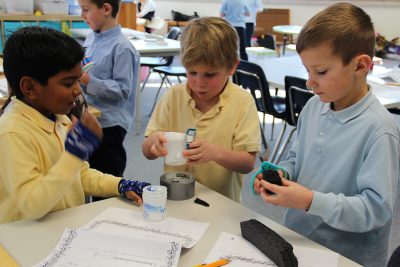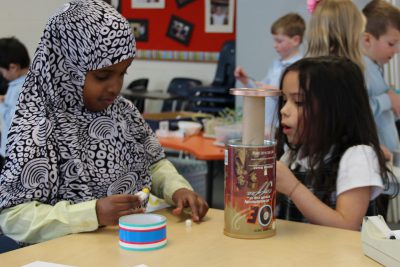February 8, 2017
 Thanks to the inventiveness of Mounds Park Academy first graders, fairy tale legend Jack survived his encounter with an infamous giant.
Thanks to the inventiveness of Mounds Park Academy first graders, fairy tale legend Jack survived his encounter with an infamous giant.
While most adaptations of Jack and the Beanstalk depict the main character’s successful descent from the castle in the clouds, the Jack featured recently in MPA’s Innovation Lab (iLab) faced an additional challenge: the giant chopped down the beanstalk leaving him stranded in the clouds! The students were tasked with creating a safe way for Jack to escape.
First, teacher Ms. O’Keefe encouraged the students to define the problem and empathize with how Jack must feel (the first two steps of design thinking). Then they developed creative solutions to reach the ground. With string, paper, pipe cleaners, rubber bands, cardboard and tape, the first graders created parachutes, planes, jet packs, and more. They constructed prototypes to test before releasing their air systems in the official rescue mission. Every Jack, effectively represented by a LEGO person, survived the descent from the cloud (also known as the Kreischer Gym balcony).
This cross-disciplinary iLab project brought together a literacy unit on fairy tales with a science unit on weather and air. Students worked in teams and followed the design thinking process—empathize, define, ideate, prototype, and test—to create an air system that would save Jack.
According to O’Keefe, “Once the challenge was introduced, the students’ wheels immediately began turning. As they worked through each stage, the students showed increased motivation and were challenged to cooperate and persevere throughout the entire process.”
The students applied what they learned about air systems—parachutes, kites, and planes—as they created a group design that allowed Jack’s successful descent.
 “After testing the designs, the students discussed what worked and what didn’t with their group members … and then they asked to do it all over again,” continued O’Keefe. “Open-ended projects like this allow student interest to cater the learning process in a natural way. Without even realizing it, they are using vocabulary and reviewing information learned across subject areas, thinking outside the box, and collaborating with group members. Showcasing their final projects before the larger group also invites students to practice their presentation skills.”
“After testing the designs, the students discussed what worked and what didn’t with their group members … and then they asked to do it all over again,” continued O’Keefe. “Open-ended projects like this allow student interest to cater the learning process in a natural way. Without even realizing it, they are using vocabulary and reviewing information learned across subject areas, thinking outside the box, and collaborating with group members. Showcasing their final projects before the larger group also invites students to practice their presentation skills.”
O’Keefe is not the only one who appreciates MPA’s use of cross-disciplinary learning and development of problem solving skills.
“I am so grateful to the MPA first graders who enabled the safe return of my baby,” exclaimed Jack’s mother. “Their innovative designs combined their kindness, scientific knowledge, and creativity to develop a solution to outsmart that giant. Thank you, MPA!”